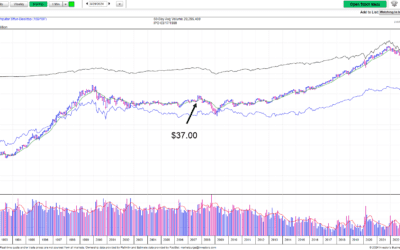Every January, it’s customary to look back on the year that was. What were the highlights? What were the “lowlights”? What events will we remember? Most importantly, what did we learn? As you know, many noteworthy and historic events happened in 2023. Conflicts in Gaza, Ukraine, and Sudan. India surpassed China as the most populous country in the world. New temperature records were set all around the globe. The use of “artificial intelligence” exploded and turned multiple industries on their heads. Chinese spy balloons and deep-sea submarines grabbed the headlines. The “Barbenheimer” phenomenon reinvigorated Hollywood.
But in some ways, one of the most notable occurrences of 2023 is actually what didn’t happen: We never entered a recession.
When 2023 began, the fear of a recession was so widespread that it almost seemed inevitable. According to one survey, 70% of economists expected a recession to hit the U.S. in 2023. Another survey found 58% of economists believed there was a more than 50% chance of a recession. For politicians, pundits, and analysts, it was practically all they could talk about.
But it never happened. Instead, the economy grew by 2.2% in the first quarter, 2.1% in the second, and 4.9% in the third. (As of this writing, the numbers for Q4 are not yet available, but it’s expected to go up again.) None of this is to say that our economy is perfect, or that we won’t have a recession in the future. But for 2023, all the gloomy forecasts simply didn’t come to pass.
Now, let’s be fair to all those economists who got it wrong: They had very good reasons for expecting a recession. Reasons based on data, logic, and history.
You see, when the year began, the U.S. was coming off a nasty 2022. While consumer prices were already coming down from their earlier highs, the national inflation rate was still 6.5%. Interest rates, meanwhile, had risen dramatically, from just above 0% at the beginning of 2022 to over 4% by the end. It was already the highest level we’d seen in fifteen years – just before the Great Recession, in fact – and every indication was that rates would continue to rise higher. All this economic pain was reflected in the stock market. The S&P 500, for example, dropped over 19% in 2022.
For economists, all this data seemed to point a clear way forward. The Federal Reserve is mandated to keep consumer prices as stable as possible. (Its target has long been to hold inflation to around 2%.) When inflation runs hot, the Fed’s main tool for lowering it is to raise interest rates. Higher rates often lead to lower consumer spending. Lower spending, in turn, prompts businesses to decrease the cost of the goods and services they provide. Essentially, higher rates create an environment where supply is greater than demand, thus cooling inflation.
But there’s a side effect to this. If spending drops too much, businesses are often forced to cut back on expansion, investment, and labor costs. This leads to a rise in unemployment…and a contracting economy. In short, a recession.
This string of events isn’t just logical. It’s supported by history. When inflation has skyrocketed in the past, the Fed’s playbook has usually worked to bring prices down…but it’s usually triggered a recession, too. Economists call this a “hard landing.”


Take a look at these two charts. The top shows interest rate levels since 1955. The gray bars indicate a recession. Notice how often a gray bar appears in the aftermath of a sharp rise in rates? Similarly, the bottom chart shows the unemployment rate. See how the gray bars always coincide with a major spike in unemployment? It’s clear that, historically, fast-rising rates often trigger a rise in unemployment…which contributes to a recession.
What about when prices come down, but the economy does not? Economists call that a soft landing, and it’s proven to be very difficult to achieve. It’s no surprise, then, that most economists predicted a hard landing in 2023.
One year later, that hasn’t happened. Interest rates did continue to rise. As of this writing, they’re at 5.3%. Inflation has continued to cool, albeit slowly. As of November, the inflation rate was 3.1%. That’s a 3.4% drop from the beginning of the year. But consumer spending has remained steady. The labor market has remained strong. The unemployment rate was only 3.7% as of November. And, as we’ve already covered, the economy has continued to grow.
From a financial standpoint, this, to me, is the major storyline of 2023. Which means we have to ask ourselves: “What can we learn from it?” As your financial advisor, I’ve taken the time to jot down a few lessons I think are worth remembering as we move into the New Year. Here they are:
#1: Always emphasize preparation over prediction. The economists who predicted a recession weren’t stupid. They used the best data they had to make the best predictions they could. But 2023 shows that even the most well-informed people simply can’t see the future. Even the near future! There are simply too many variables to consider. That’s why, as investors, we must always emphasize planning over predicting. We can’t predict when the markets will drop nearly 20%, as they did in 2022, or when they’ll rise by well over 20%, as they did in 2023. What we can do is plan ahead for what we’ll do if the markets fall, or if they rise. We can prepare mentally and financially for both market storms and market sunshine, so that we can weather the former and take advantage of the latter.
When we predict, we’re essentially swinging for the fences on every pitch. Occasionally, a prediction can lead to a home run…but it can also lead to a lot of strike outs. By planning, we don’t have to swing at all. Since we can’t control the situation, we simply make the best out of every situation. We control only what we can control – ourselves.
#2: Be wary of confirmation bias. Earlier in the year, I spoke to many people who were convinced a recession would happen. Because of that, they tended to disregard all data that pointed away from a recession, and only valued information that confirmed what they already believed. As a result, many investors missed out on a stellar year in the markets! This is another example of why preparing is so much better than predicting. It removes emotion from our decision-making. Because we’re not so focused on “being right,” we can focus instead on “being ready!”
#3: Remember that past performance is no guarantee of future results. You’ve probably seen this line in the past, and 2023 is a great example of why. Just because rising interest rates have led to recessions in the past doesn’t mean they always will. Just because the markets went one direction yesterday doesn’t mean they’ll go the same direction tomorrow. While history is a great resource to draw from when making decisions, it’s just a guide, not a guarantee.
#4: At the same time, don’t anchor to the present. As humans, we have a natural tendency to think that the way things are today is how they’ll be tomorrow. When 2022 ended, many investors felt that 2023 would be much the same. Now, we run the risk of thinking that just because a recession didn’t happen last year, it won’t happen this year.
Again, it all goes back to planning and preparation. Here at Braeburn Wealth Management, we will continue to prepare for all possible outcomes. We’ll plan for how to reach the outcomes we want and avoid the ones we don’t. But instead of predicting, instead of assuming, instead of anchoring, we will accept that the future is written in clay, not stone. Only when it becomes the past does it harden. So, when you get right down to it, the lesson of 2023 is this: The future is flexible, and so we must be flexible, too. By doing this, we can continue shaping your future into whatever it is you want it to be.
So, that’s 2023! We hope it was a wonderful year. On behalf of the entire team, we look forward to making 2024 even better. Have a Happy New Year!




